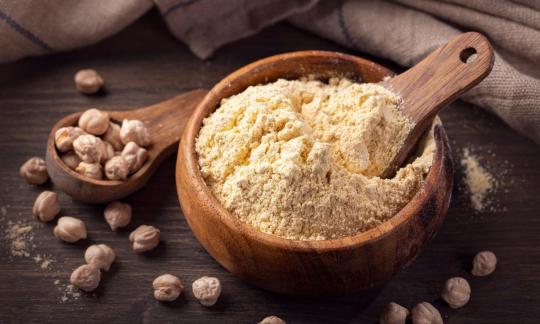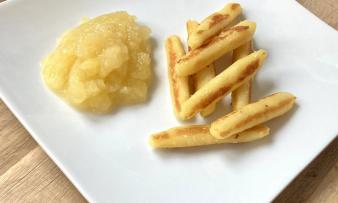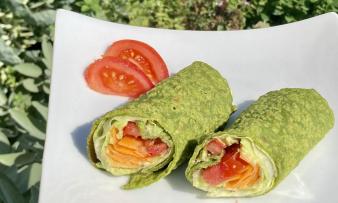Table of contents
Chickpea flour is the flour made from finely ground chickpeas, which can be used to make various gluten-free doughs. Flour made from raw chickpeas should not be eaten raw, whereas roasted flour is suitable for processing raw dishes. Organic quality is preferable.
Use in the kitchen
Chickpea flour is flour that is made by grinding peeled, dried chickpeas ( Cicer arietinum ). It has a beige-white to slightly yellowish color and a nutty-sweet taste. Like the chickpea itself and other pulses, chickpea flour is a rich, purely plant-based, i.e. vegan, source of protein. 1 In addition, the flour from the beige legume is naturally gluten-free and can be used as an alternative to wheat flour or spelt flour . Since chickpea flour binds more moisture than wheat flour, you should use 75 g of chickpea flour per 100 g of wheat flour when replacing it.
The flour has many uses - whether for baking or cooking and for preparing hot, cold, sweet or salty dishes. The flour is traditionally used in a variety of Indian dishes such as pakoras, boondi and laddu (ladoo). 1 In the Arab world, chickpea flour is used, often in combination with pureed, cooked chickpeas, to make falafels . In Nice, people eat 'Socca de Nice', while in Italy they eat 'Farinata' - both pancakes made from chickpea flour and olive oil .
Chickpea flour is ideal for making all kinds of doughs, e.g. for flatbread, pizza, pasta (e.g. vegan and gluten-free potato dumplings ), omelettes, waffles and cakes. It can also be used to make delicious wraps, such as the spinach and chickpea wraps with raw vegetable filling . Added to wheat flour in yeast bread dough, it can be used to make a delicious bread. However, if you only use chickpea flour for the yeast dough, it will not rise.
The yellowish flour can also be used to thicken sauces, soups, spreads and purees and it serves as a binding agent for vegan patties, meatballs and more. Chickpea flour has also proven to be a capable vegan egg substitute. 1 tablespoon of chickpea flour mixed with 2 tablespoons of water replaces an egg. This can be used to bread vegetables or vegan meat alternatives without eggs.
In terms of taste, spices and spice mixtures such as paprika, chili, cumin, garlic, garam masala and cinnamon and herbs such as coriander, thyme and basil go particularly well with recipes containing chickpea flour.
Can you eat chickpea flour raw? Chickpea flour is usually made from unroasted, raw chickpeas. Since raw chickpeas contain substances (lectins) that are toxic to humans, neither the whole peas nor the flour made from them should be eaten raw. Heating them destroys the toxins. With finely ground chickpeas, i.e. chickpea flour, briefly frying them in a pan is enough (e.g. in the form of pancakes). To prepare cold, unheated dishes, raw chickpea flour must be heated briefly before use or flour made from roasted chickpeas (available in stores) can be used.
Homemade
Chickpea flour is easy to make yourself. All you need is raw, dried chickpeas and a high-performance blender. Put the chickpeas in the high-performance blender and grind at the highest setting for about 1 minute until you have a fine flour. The homemade flour can now be used for cooking and baking, but never for eating raw.
Vegan recipe for "scrambled eggs" with chickpea flour
Ingredients (for 2 people): 100 g chickpea flour (organic), 1 teaspoon baking powder, ½ teaspoon kala namak salt, ½ teaspoon turmeric, ½ teaspoon paprika powder, 240 ml water, 2 spring onions, 1 tomato, 1 tablespoon rapeseed oil, some salt andpepper .
Preparation: Put the chickpea flour in a bowl. Add the baking powder, spices and water. Mix to form a liquid dough and leave to swell for about 10 minutes. Rinse the spring onions and tomatoes, cut into rings or cubes and sauté in a frying pan heated with rapeseed oil. Add the dough, mix together and break or stir into small pieces with a spatula while frying. Reduce the heat and let the vegan scrambled eggs rest for a while. Serve with fresh (or toasted) wholemeal bread slices.
Vegan recipes with chickpea flour can be found under the note: " Recipes that have the most of this ingredient ".
| Not only vegans or vegetarians should read this: Vegans often eat unhealthily. Avoidable nutritional errors . |
Purchasing - Storage
Many supermarkets (e.g. Coop, Migros, Denner, Aldi, Rewe, Edeka, Billa ) have chickpea flour on offer all year round (some of it organic). Others (e.g. Volg, Lidl, Hofer, Spar ) may offer the flour during special promotions. Organic chickpea flour can be found in organic supermarkets (e.g. Denn's Biomarkt, Alnatura ) and health food stores. Make sure that the flour is made from raw or roasted chickpeas - only roasted chickpea flour is suitable for direct consumption or further processing without heating.
The availability of chickpea flour varies depending on the size of the store, catchment area, etc. You can find our recordedfood prices for the DA-CH countries above under the ingredient image - and by clicking you can see their development at various suppliers.
Storage tips
Chickpea flour is best stored in an airtight container (e.g. in a storage container) in a dry, cool place protected from light. This way the flour will last for 1-2 years.
Ingredients - Nutritional values - Calories
The energy content of chickpea flour is 387 kcal/100g. Carbohydrates are 58 g/100g (of which 11 g sugar and 11 gfiber ) and fat is 6.7 g/100g. Chickpea flour is a protein-rich flour with 22 g/100g. In comparison: wheat flour and light spelt flour have 12 g, whole wheat flour 13 g and whole spelt flour 14 g of protein per 100 g. Coconut flour (21 g/100g) is also rich in protein, but lupine flour exceeds the protein content of both flours with 38 g/100g. 2
The amount of folate in chickpea flour is very high at 437 µg/100g. This covers 219% of the daily folic acid requirement. No other flour (that we know of) contains more of the vitamin, not even the nutrient-rich lupin flour (188 µg/100g). Wholemeal spelt flour (50 µg/100g), wholemeal wheat flour (44 µg/100g), wholemeal corn flour (25 µg/100g), potato flour (25 µg/100g) and rice flour (4 µg/100g) contain significantly less folate. 2 Note: Folate is a water-soluble, heat-sensitive vitamin, which is why cooking and baking reduces the folate content of foods, including chickpea flour.
100 g of chickpea flour also contains 1.6 mg of manganese (80% of the daily requirement). The manganese content of rice flour (1.2 mg/100g) and light spelt flour (1.2 mg/100g) is close to that of chickpea flour. Lupine flour (2.5 mg/100g), wholemeal spelt flour (3.3 mg/100g) and wholemeal wheat flour (4.1 mg/100g) are even richer in manganese. 2
The 166 mg of magnesium contained in 100 g of chickpea flour covers 44% of the daily requirement. A similar amount is contained in whole wheat flour (137 mg/100g). Lupine flour contains slightly more of the mineral at 208 mg/100g. Wheat bran is an extremely good source of magnesium at 611 mg/100g. 2
The complete ingredients of chickpea flour, the coverage of the daily requirement and comparison values with other ingredients can be found in our nutrient tables. In the article Nutrients explained you will get a detailed insight into the topic.
Health effects
Chickpea flour is nothing more than ground chickpeas (peeled, dried). The health benefits of the flour can therefore be derived from those of the legume.
Both chickpeas and their flour are particularly rich in protein. Chickpea products also have a considerable fiber content. High-fiber foods are particularly recommended for overweight people who are trying to lose weight. In addition, fiber (also called dietary fiber) can improve laxatives, lower blood sugar and cholesterol levels, and reduce the risk of stroke, type 2 diabetes, coronary heart disease, gastrointestinal disease, and high blood pressure. 3,8
Secondary plant substances
Many of the health effects of chickpea flour can be attributed to the secondary plant substances it contains. Our article on secondary plant substances provides an overview of the classification of substance groups, their occurrence in foods and possible effects on humans. Chickpea flour contains the following secondary plant substances:
- Isoprenoids: triterpenes (saponins), tetraterpenes ( carotenoids ) 4.6
- Alkaloids 6
- Polyphenols: Phenolic acids: hydroxybenzoic acids (salicylic acid, gallic acid, vanillic acid, anisic acid), hydroxycinnamic acids (chlorogenic acid, ferulic acid, caffeic acid, cinnamic acid, p-coumaric acid, isoferulic acid); Flavonoids: flavonols, flavones, anthocyanidins, isoflavones, tannins (proanthocyanidins) 3,4,5,6,7
- Other organic compounds: ketones, hydroxycarboxylic acids (tannic acid) 4
- Protease inhibitors: ( phytic acid ) 6
However, it should be noted that the composition of the secondary plant substances in chickpea flour can vary depending on the variety, time of harvest and growing conditions. Therefore, quantities are only of limited use and should only be understood roughly.
Studies have shown that chickpeas and chickpea flour exhibit multifunctional activities associated with the bioactive peptides (short amino acid chains) and phytochemicals (secondary plant substances) they contain. Various chickpea proteins and peptides have been shown to have antibacterial, antioxidant, hypolipidemic, antihypertensive and antitumor effects. 3,4, 5
Flavonoids, including isoflavones, have antioxidant and antibacterial effects and are used in the treatment of various diseases such as cancer, hyperlipidemia, osteoporosis and cardiovascular diseases. 4,5, 6 Other phenolic compounds such as phenolic acids are also considered antioxidants. 3 Other health benefits of chickpeas, according to studies, include anti-allergic, anti-fungal, anti-inflammatory, antispasmodic, stomach and liver protective properties. 5,9
A 2023 study compared the nutritional values of chickpea flour and durum wheat flour and argued in favor of mixtures of both. Adding chickpea flour to durum wheat flour increased the content of minerals, proteins, fiber, fat and energy, while decreasing carbohydrates. Flour mixtures containing chickpea flour are therefore beneficial for people with mineral and protein deficiencies, but also for people suffering from obesity, diabetes and heart disease due to the lower carbohydrate content. 7 Both raw and processed (made from heated, dried chickpeas) chickpea flour show higher nutritional value compared to refined wheat flour . 8
Dangers - Intolerances - Side effects
In addition to all the health-promoting ingredients of chickpeas, they also contain anti-nutritional substances (antinutrients) that have a negative effect on the human body and can disrupt the digestive process. It is believed that the accumulation of antinutrients in legumes has developed as a protective mechanism in unfavorable environmental conditions and the presence of parasites, fungi, insects and herbivores. The antinutrients found in legumes are divided into two categories: proteinaceous and non-proteinaceous anti-nutritional substances. Anti-nutritional protein compounds include alkaloids, phytic acid, oligosaccharides and phenolic compounds such as tannins and saponins. Known antinutrients found in legumes include lectins (agglutinins), trypsin inhibitors and chymotrypsin inhibitors. Chickpeas have been found to contain protease and amylase inhibitors, lectins, phytic acid and some oligosaccharides belonging to the raffinose sugar family, which make eating the legume raw harmful. According to a 2016 study, more than 4 g of amylase inhibitors (more than 100 g of chickpeas) can cause abdominal discomfort and diarrhea. However, processing methods such as soaking, sprouting or cooking (heating) can reduce or even inactivate the anti-nutritional compounds. 4,6,10 Cooked chickpeas or heated chickpea flour are therefore safe to eat.
Some oligosaccharides (raffinose and stachyose) can cause unpleasant flatulence. However, the flatulent effect can be avoided by cooking and sprouting. 10
Chickpeas (and therefore chickpea flour) can trigger allergic reactions in sensitized people, ranging from skin reactions to anaphylaxis. 4
Although chickpeas and pulses in general are naturally gluten-free, caution should be exercised with products made from chickpea flour. Look for the crossed-out ear of corn or similar gluten-free symbols. Otherwise, the products could come from mills that also process wheat and thus be contaminated with wheat flour dust. 11
Ecological footprint - animal welfare
The CO 2 footprint of a food depends on various aspects, such as cultivation method (conventional/organic), seasonality, country of origin, processing, transport and, if applicable, packaging. According to a Danish climate database Concito, the CO 2 footprint of canned chickpeas is 1 kg CO 2 eq/kg. 12 A German study from 2020 measures the CO 2 footprint of canned chickpeas at 1.3 kg CO 2 eq/kg. 13 According to CarbonCloud, 1 kg of European chickpea flour causes 1.2 kg CO 2 eq. 14
Pulses such as chickpeas, but also beans, soybeans, lentils and peas are considered healthy plant-based sources of protein due to their high protein content. They have a better environmental impact than meat products. Their ecological footprint is smaller because they require less land and water and cause significantly fewer CO 2 emissions. 13,15,16
The production of 1 kg of chickpeas requires 4177 litres of water. However, this figure does not indicate whether the chickpeas are fresh or dried. The water footprint is lower than that of lentils (5874 litres) or dried beans (5053 litres) and is significantly lower than that of the production of 1 kg of beef (15,400 litres). 16 ,17
For detailed explanations of various sustainability indicators (such as ecological footprint, CO2 footprint, water footprint), see our article: What does the ecological footprint mean?
Although a 2022 study classified processed pulses (e.g. canned cooked chickpeas, presumably also chickpea flour) as less sustainable than dried pulses, they generally have a low impact on the environment and climate, especially compared to meat products. The study concludes that the consumption of pulses should be encouraged regardless of their form or type (e.g. processing), rather than guiding consumers to choose the most sustainable option among pulse-based foods. 18
When shopping, you should look for regional organic products, because organic farming does not use synthetic pesticides. In conventional farming, on the other hand, large quantities of pesticides and herbicides (such as glyphosate) are used when growing legumes, and not just to control weeds. These have been proven to have a negative impact on the environment and health. In desiccation, a practice to speed up the harvest, the crop is deliberately killed using herbicides. This dries out the plant and the crop ripens more quickly. Accordingly, there can be an increased concentration of this agent in the end product, especially in legumes and grains. 19,20
Worldwide occurrence - cultivation
The earliest evidence of the use of chickpeas as food was found in Turkey (7500-6800 BC) and in Syria (8th millennium BC). In these remains it is often not possible to distinguish between the wild predecessor ( Cicer reticulatum ) and the domesticated chickpea ( Cicer arietinum ). The cultivation of chickpeas is well documented from 3300 BC in Egypt and the Middle East. 21
The chickpea spread throughout the Mediterranean and reached South and West Asia and as far as Ethiopia. In the 16th century AD, the Spanish and Portuguese introduced the chickpea to the New World. Chickpeas (of the Kabuli type) reached India from the Mediterranean via the Silk Road in the 18th century. 21
Chickpeas are mainly cultivated in temperate and semi-arid regions of Asia, Europe, Australia and North America. 5 The largest producer of chickpeas in 2022 was India, followed by Australia, Turkey, Ethiopia and Russia. In Europe, chickpeas are grown in Bosnia and Herzegovina, North Macedonia, Portugal, Moldova and Ukraine. 22
Industrial production
To produce chickpea flour, you need dried chickpeas. The first step is to clean and sort them. The brown shells are then removed from the chickpeas using machines. After soaking, machines peel or de-shell the chickpeas. To make raw chickpea flour, the dehydrated chickpeas are finally ground into flour and sieved before packaging. To make roasted chickpea flour, the dried chickpeas are subjected to a heat treatment (roasting) before being ground into flour. 23
Further information
Chickpeas ( Cicer arietinum ) belong to the legume family (Fabaceae) and the subfamily of the Faboideae. Despite its name, chickpeas are not closely related to peas ( Pisum sativum ). The German name chickpea is probably derived from the Latin species name Cicer arietinum, which could be derived from the Hebrew word "kikar" (round, plump). The English name chickpea also seems to have the same origin and probably has nothing to do with chickens. 24
Chickpeas are divided into two types/varieties: Kabuli and Desi. Kabuli chickpeas have a larger, rounder grain with a lighter seed coat compared to the smaller, darker Desi chickpeas. 9 About 80-85% of the total chickpea cultivation area is for the Desi type (especially in Asia and Africa). The main countries that grow Kabuli chickpeas are Europe, North Africa, West Asia and North America. 3 The consumption of chickpeas is widespread and varies depending on economic, historical and socio-cultural factors. The main consumer of the world's most consumed Desi type is South Asia (including India). Kabuli chickpeas are consumed mainly outside South Asia because they are easier to produce and more profitable. Although there are several ways to consume Kabuli chickpeas, they are most commonly used in the preparation of hummus or as cooked canned legumes. 9
Due to the physiological benefits of chickpeas, attempts have been made to encourage consumers to consume more of the legume by incorporating it as flour into other food products, such as bread, pasta, biscuits and cakes. Incorporating chickpea flour into products made from durum wheat flour improves the nutritional value. 7,8
Alternative names
There are the following alternative names for chickpeas: Garbanzo beans, real chickpeas, Roman chickpeas, Venus chickpeas or field peas.
In English, chickpea flour is called chickpea flour, gram flour or besan.
Other uses
Chickpea flour can be used not only in cooking but also in skin care. Mixed with a little water, it can be used as a natural skin cleanser with a peeling effect.










Comments